If you ask a Sri Lankan, what is the most significant cultural event of the year, you will undoubtedly hear the answer as the Kandy Esala Perahera. Celebrated annually either July or August, even 2024 has plans for a grand celebration for the Kandy Esala Perahera. What’s so special about the Kandy Esala Perahera in 2024? Let’s find out..
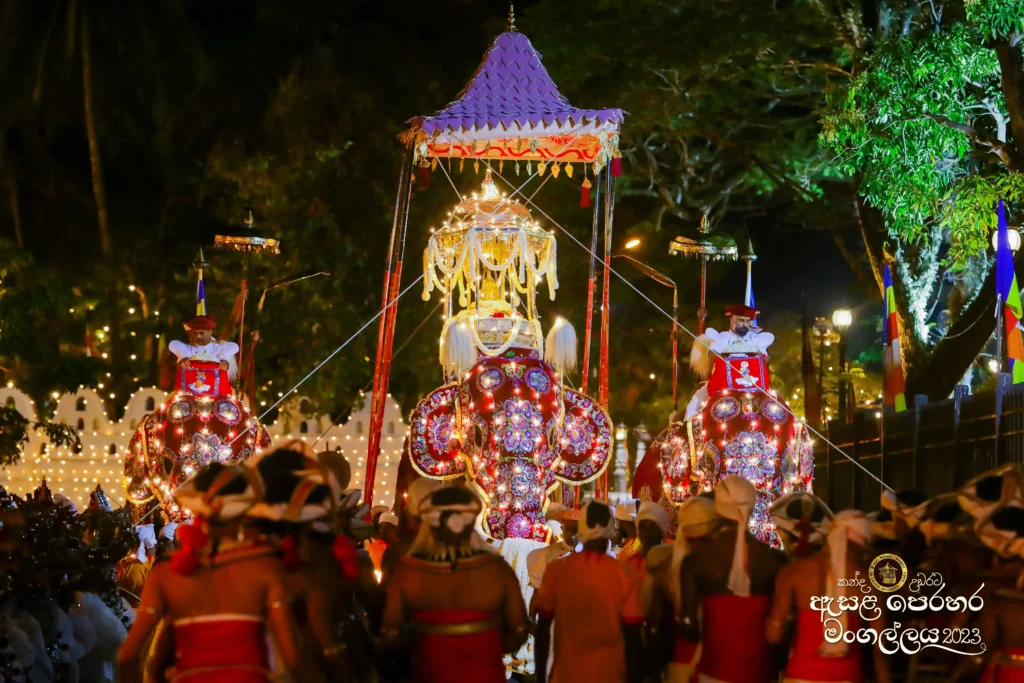
Your guide to Kandy Esala Perahera
A grand procession or pageant with a lot of inclusions of the Sinhala and Buddhist traditions make the Kandy Esala Perahera one of the most celebrated events of Sri Lanka. Devotees & visitors engage in a lot of traditions and practices to make this event a total success and with the help of Social Media, content related to the Kandy Esala Perahera has gained a lot of attention of the netizens. Deep-rooted traditions, Buddhist practices, dances and performances, very colorful and vibrant costumes and attires, largest mammals on Earth – Elephants, all make the Kandy Esala Perahera one of the most vibrant festivals in Asia.
What is the Kandy Esala Perahera?
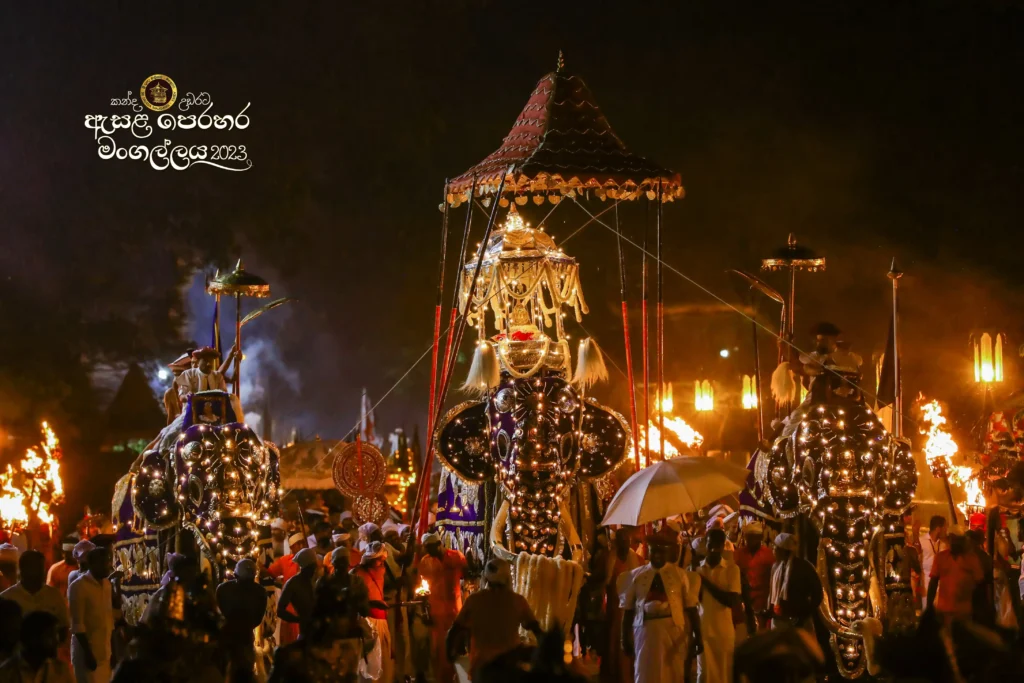
Simply said, this is a Buddhist Festival and celebrated hosted in the city of Kandy in Sri Lanka. The Kandy Esala Perahera is a Ten-day celebration with increasing glamour of the Perahera – the Sinhalese word for Procession, honoring the Sacred Tooth Relic of Lord Buddha. Though it’s said and celebrated as a Buddhist Festival to honor Lord Buddha, Sri Lanka being a multi-cultural country has many Hindu-traditions and religion aspects blended to this ceremony.
if you ask a Sri Lanka, preferably a Non-Buddhist, they will tell you that the Kandy Esala Perahera is a Powerful symbol of Sri Lanka’s Identity. This ceremony unites people across many faiths and backgrounds in a shared celebration of Sri Lanka’s rich cultural heritage.
History of the Kandy Esala Perahera
The origins of Esala Perahera
Sri Lanka is one of the richest countries in the world when it comes to History, Culture, and Traditions. In fact, it’s said that the Origins of the Esala Perahera roots back to 3rd Century BCE – to the reign of King Devanampiya Tissa. Back in those days, Buddhism was not introduced to Sri Lanka. So, the origins are rooted with a Ritual to invoke the Blessings of the gods for a Good Harvest (Sri Lanka is still an agriculture-based country).
Now let’s see how the Buddha’s Tooth Relic blended with this Esala Celebration and the fusion made into the Kandy Esala Perahera.
Journey of the Sacred Tooth Relic to Kandy
543 BCE:
According to legend, the Tooth Relic was retrieved from Buddha’s funeral pyre.
4th Century AD: (Circa 310-328 AD)
The Tooth Relic was brought to Sri Lanka during the reign of King Kirthi Sri Meghavarna of Anuradhapura.
Historical reference: The Mahavamsa mentions this event, describing how the relic was smuggled from India in the hair of Princess Hemamala.
4th – 11th Centuries: Tooth Relic remained in Anuradhapura
Historical reference: Chinese monk Fa-Hien visited Sri Lanka in the 5th century and mentioned the veneration of the Tooth Relic in his writings. Fa-Hien (5th century CE), in “A Record of Buddhistic Kingdoms”: While he doesn’t explicitly mention the Tooth Relic, he describes the reverence for Buddha’s relics in Sri Lanka: “In the city there is a temple dedicated to the Buddha’s tooth, where the people all go to pay their vows.”
1017 AD – 1232 AD: Relic moved to Polonnaruwa
The relic was moved to Polonnaruwa when it became the capital.
13th – 14th Century AD: Dambadeniya, Yahapuwa, Kurunegala, Gampola Kingdoms
As the kingdom shifted, the relic moved to Dambadeniya, then Yapahuwa, Kurunegala, and Gampola.
Historical reference: The Culavaṃsa, a historical chronicle, mentions these movements.
1400 AD to 1592 AD: Kotte Kingdom
Historical reference: Portuguese historian Diogo do Couto wrote about seeing the relic in Kotte in the 16th century.
1544 AD – 1551 AD: Briefly held in Sitawaka Kingdom
1592 AD: Brought to Kandyan Kingdom
The relic was finally brought to Kandy by King Vimaladharmasuriya I.
Historical References: Robert Knox (1681), “An Historical Relation of the Island Ceylon”:
While Knox doesn’t directly describe the Esala Perahera, he mentions religious processions:
“In some of their Festivals they carry their Gods in Procession upon Elephants, most richly covered with Silk and Cloth of Gold and Silver.”
1775 AD: Formalized of Including the Buddha’s Tooth Relic to Esala Perahera
1815 AD to Present: Tooth Relic still in Kandy and celebrated with the Esala Perahera
Historical Reference: John Davy (1821), “An Account of the Interior of Ceylon”: “The procession was led by elephants… Next followed the officers of the temples and of the king’s household, and after them dancing-girls and musicians… The last and most important personage in the procession was a priest, who rode on an elephant under a canopy, and held before him the casket, containing the relic of Buddha.”
Historical Reference: Sir James Emerson Tennent (1859), “Ceylon: An Account of the Island”:
“The Perahera at Kandy is at once a revival and a memorial of this ancient festival… the sacred tooth of Buddha is carried in procession, enclosed in a golden casket, and mounted on the state elephant.”
Historical Reference: H.C.P. Bell, in his Archaeological Survey of Ceylon reports (late 19th century):
“The Esala Perahera is undoubtedly the most magnificent spectacle in Ceylon… its origin is lost in the mists of antiquity.”
Kandy Esala Perahara after the formal procedures established by the Kings

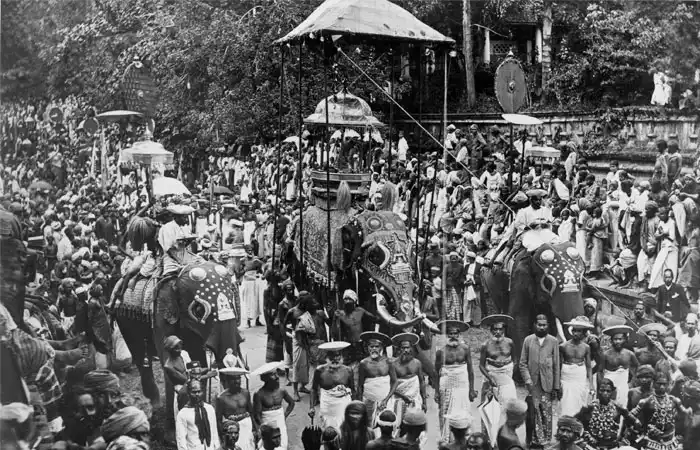
Dantha Dathu Charitha or Dalada Siritha
It was written during the reign of Parakramabahu IV (1302-1326) of Kurunegala and is considered one of the most important sources for understanding the rituals and customs associated with the Sacred Tooth Relic. The Dalada Siritha details numerous regulations (38 Statues) regarding the care and veneration of the Tooth Relic, including how processions should be conducted
The rituals including cleaning the shrine room at an auspicious hour, decorating with silk clothes, making offerings, and moving the relic casket with great reverence, are all consistent with the practices outlined in the Dalada Siritha.
Formalized by King Kirthi Sri Rajasinghe
In 1775, King Kirthi Sri Rajasinghe formalized the structure of the modern Esala Perahera, decreeing that the Sacred Tooth Relic should be carried in the procession. This tradition continues to this day, making the Perahera a living link to Sri Lanka’s ancient past.
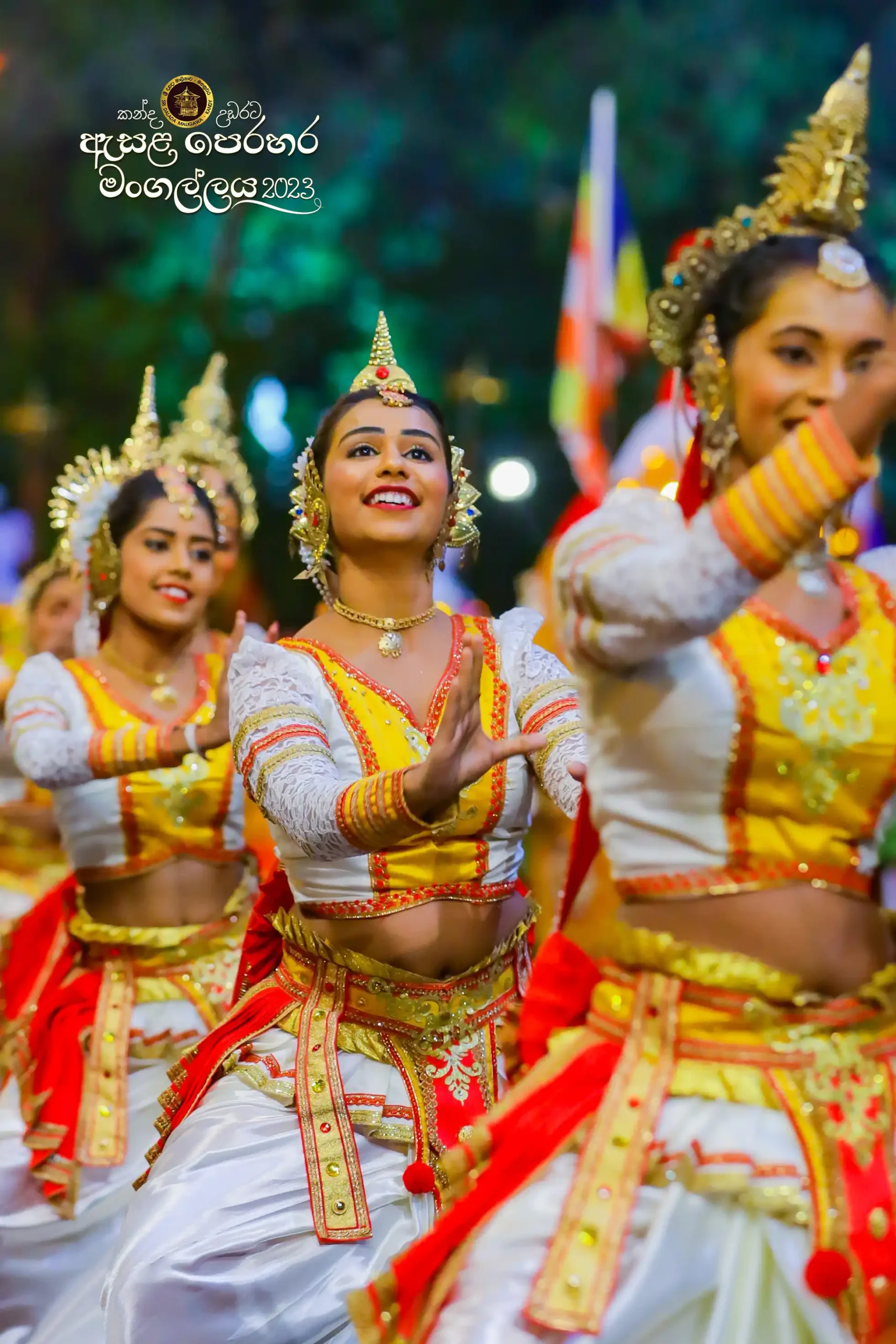
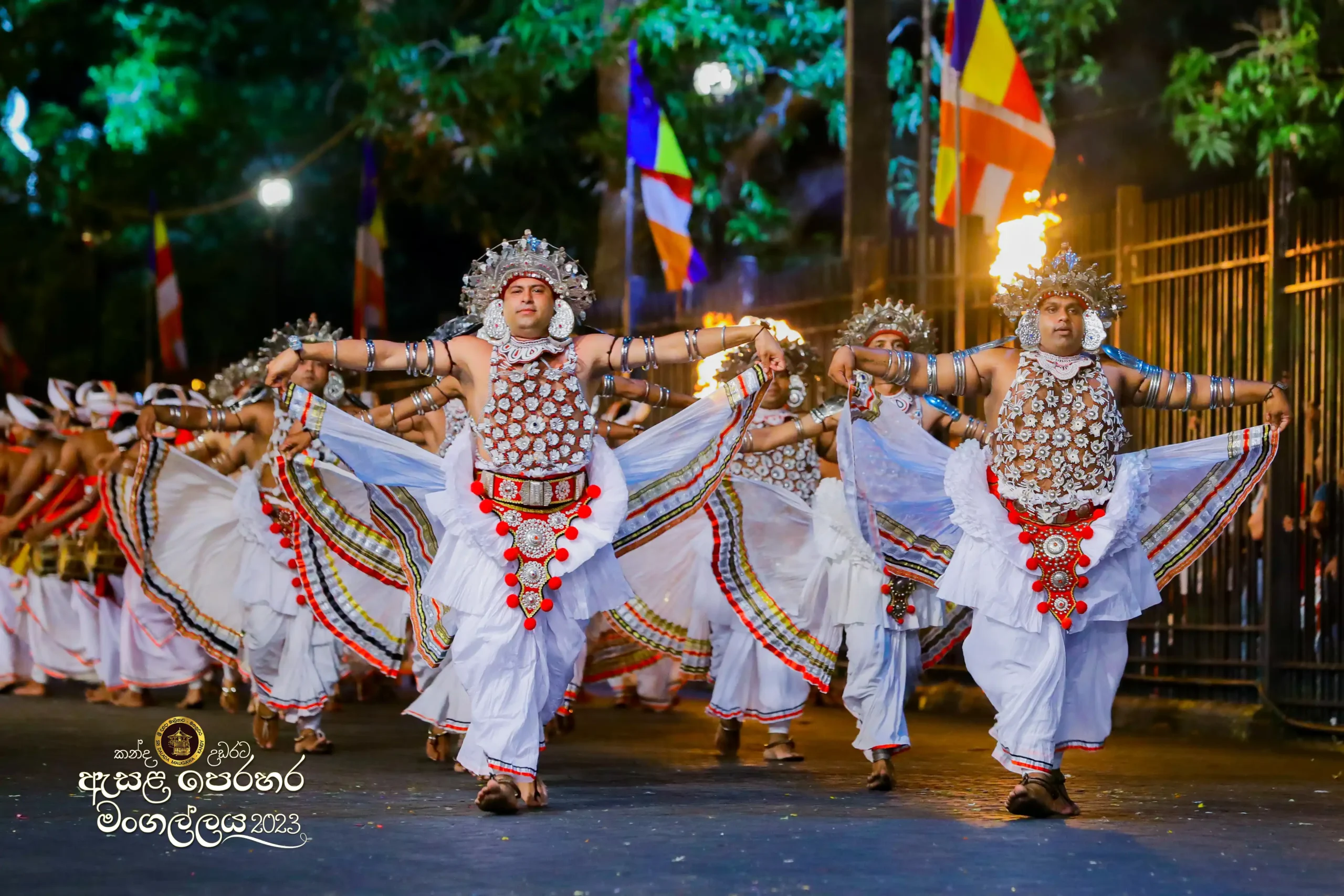
Kandy esala Perahera – Essential information
When is the Kandy Esala Perahera
The Kandy Esala Perahera typically takes place in July or August, coinciding with the Esala full moon. In 2024, the exact dates will be determined based on the lunar calendar. The festival lasts for ten days, with the grandest processions occurring on the final five nights.
Dates of Kandy Esala Perahera in 2024 are from 10th August 2024 to 19th August 2024.
Where is the Kandy Esala Perahera
In the city of Kandy, Sri Lanka 🇱🇰
The Perahera begins at the Sacred Temple of the Tooth (Sri Dalada Maligawa) in Kandy. It then winds through the city’s main streets, covering a route of about 5 kilometers. The procession typically starts in the evening and continues well into the night.
Kandy Esala Perahera Route
First to Fifth Kumbal Perahera Route and Starting times for 2024
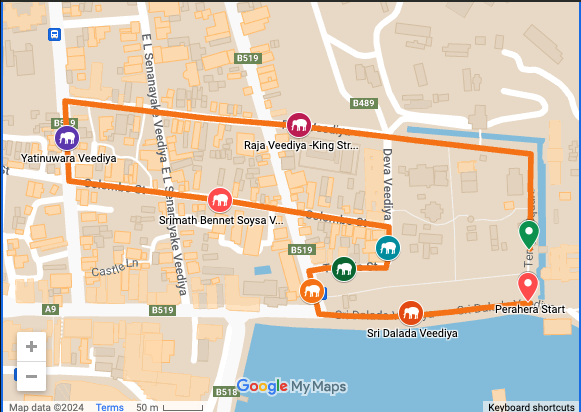
1st Kumbal Perahera
10th August 2024
Starting at 06.06 PM
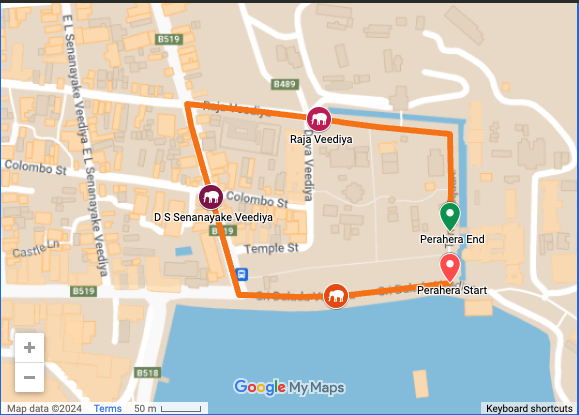
2nd Kumbal Perahera
11th August 2024
Starting at 07:22 PM

3rd Kumbal Perahera
12th August 2024
Starting at 07:22 PM
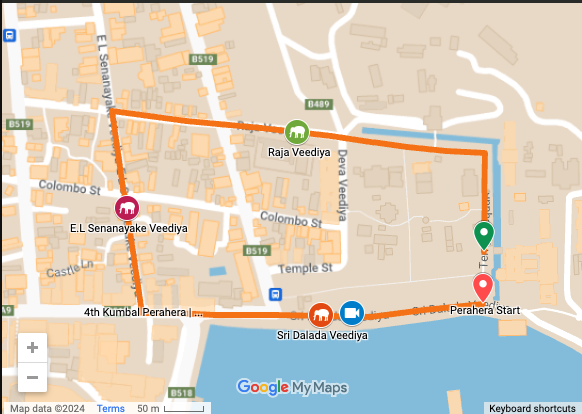
4th Kumbal Perahera
13th August 2024
Starting at 07:20 PM

5th Kumbal Perahera
14th August 2024
Starting at 07:15 PM
First to Fifth (Final) Randoli Perahara Route and Starting Times in 2024
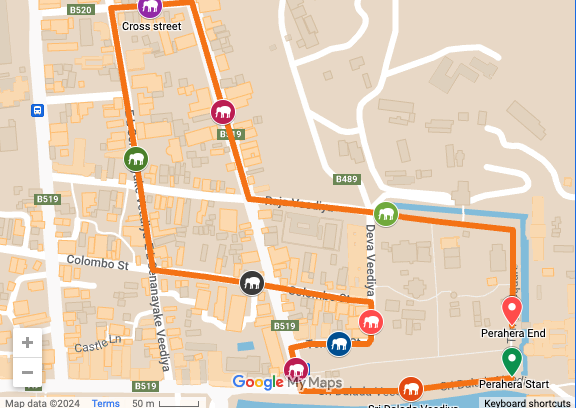
1st Randoli Perahera
15th August 2024
Starting at 06:45 PM
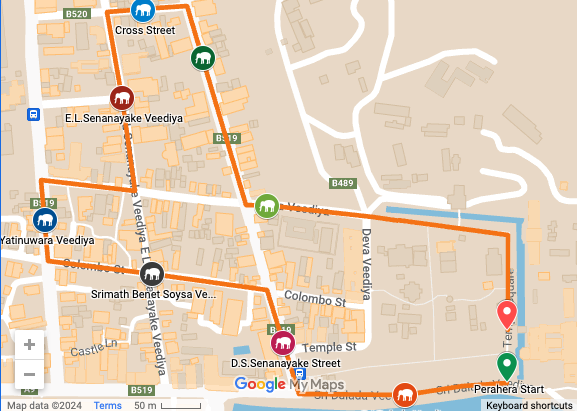
2nd Randoli Perahera
16th August 2024
Starting at 07:08 PM
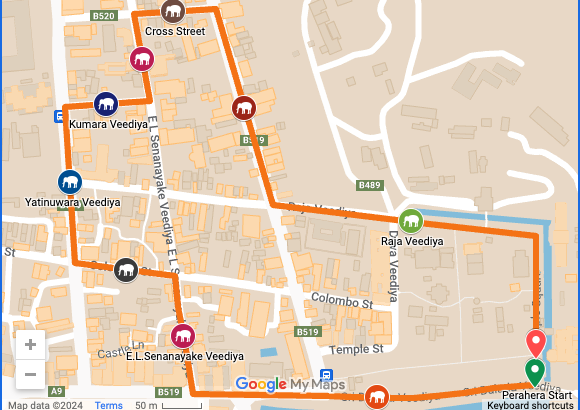
3rd Randoli Perahera
17th August 2024
Starting at 06:57 PM

4th Randoli Perahera
18th August 2024
Starting at 06:40 PM
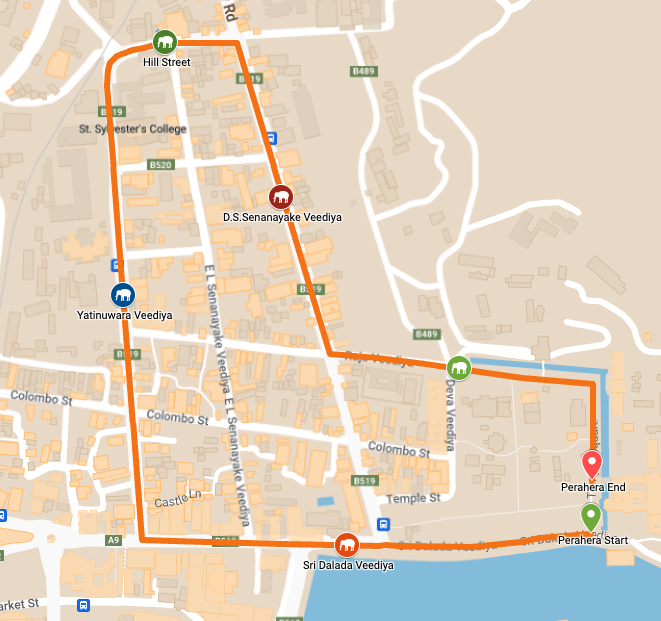
5th (Final) Randoli Perahera
19th August 2024
Starting at 06:57 PM
Day Perahera (Dahawal Perahera) 2024: Route and Starting time

Dahawal Perahera (Day Procession)
20th August 2024
Starting at 02:11 PM
What to see at Kandy Esala Perahera
The Five Peraheras
The Kandy Esala Perahera actually consists of five separate processions:
- Mahawahalkada Perahera
- Natha Devale Perahera
- Vishnu Devale Perahera
- Katharagama Devale Perahera
- Pattini Devale Perahera
Each of these represents a different deity or aspect of Sri Lankan spiritual life, coming together in a grand display of unity and devotion.
Highlights of the Kandy Esala Perahara
Elephants
Majestically adorned elephants, including the Maligawa Tusker carrying the sacred relic casket, form the heart of the procession.
Dancers
Hundreds of traditional Kandyan dancers perform intricate routines, their rhythmic movements a testament to centuries-old traditions. On a personal note, the dancing and the permission to dance at the Kandy Esala Perahera is passed-down from generation to generation. A lesser known fact about the Dancers and Participants for the Esala Perahera practices is, they have to Abstain from all Meat, Egg, Milk items for 3 weeks before the Perahera day starts. In Sri Lanka we call this as “Pewenawa”.
Musicians
Drummers, Flutists, traditional musicians create one of the best viewing experiences to the public.
Torch-Bearers and Whip-Crackers
Adding drama and spectacle, these performers light up the night and clear the way for the procession.
The Sacred Tooth Relic of buddha – the heart of esala perahera in kandy
The Sacred Tooth Relic of Buddha, believed to be an actual tooth of Gautama Buddha, is the focal point of the entire festival. According to legend, this relic was rescued from Buddha’s funeral pyre in 543 BCE and smuggled into Sri Lanka in the 4th century AD, hidden in the hair of Princess Hemamala.
During the Perahera, a replica of the relic casket is carried on the back of a beautifully adorned elephant, symbolizing the presence of Buddha himself in the procession. This act of parading the relic is believed to bless the land and its people, ensuring prosperity and abundance. You can notice thousands of devotees flock on the sides of the roads to worship this and chant Prayers (Gatha) asking for blessings.
Planning Your Visit to Kandy Esala Perahera
Best Viewing Spots for Kandy Esala Perahera
For the best views, consider booking a seat at one of the viewing stands along the route. Alternatively, arrive early to secure a spot along the streets. Popular locations include in front of the Queen’s Hotel and near the Temple of the Tooth.
There are many vendors who sell tickets for Seats for the Kandy Esala Perahera. These prime-locations have good viewing angles of the Perahera and start prices from USD 30 and up per person per seat.
You can also notice that many tourists, locals come in the Mornings and make themselves a seat by the road until the Esala Perahera starts. It’s regular thing to see people and families flock at the roads to secure a super spot to view the Esala Perahera.
Dress Code and Etiquette
Dress modestly out of respect for the religious nature of the event. Cover shoulders and knees, and be prepared to remove shoes if entering temple grounds. Remember, this is a sacred event for many attendees, so maintain a respectful demeanor throughout.
Photography & Videography Tips
While photography is generally allowed, be mindful of using flash, which can startle the elephants. For the best shots, bring a camera that performs well in low light conditions. Always ask permission before photographing individuals, especially those in traditional costumes.
Where to Stay in Kandy?
If you are wondering where to stay in Kandy during the Esala Perahera, first and most important message is, Book before you come. All hotels from Homestay to Luxury Boutique Hotels in Kandy are fully booked months-ahead because thousands, hundreds-of-thousands flock to Kandy to participate in this event. You can connect with MESHAUN Journeys and we will find you cheaper and affordable hotel options.
Impacts of the Kandy Esala Perahera
The Kandy Esala Perahera plays a crucial role in preserving Sri Lankan heritage. It provides a platform for traditional arts like Kandyan dancing and drumming to be showcased and passed down to younger generations. The festival also contributes significantly to the local economy, supporting artisans, performers, and the tourism industry.
When you visit Kandy during the day-time you can notice how the performers, staff get ready for the evening functions. A common sight near the Kandy Temple is the bathing of the Elephants on the parking grounds. That’s a really nice sight to see.
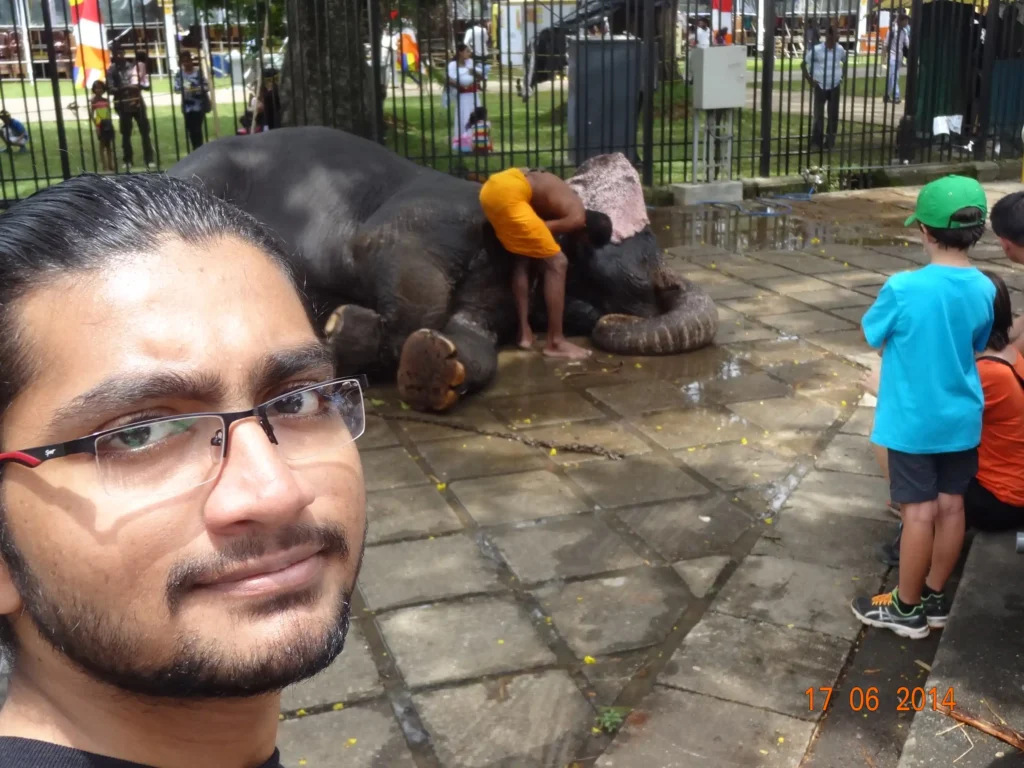
Planning to visit the Kandy esala Perahera?
Let’s make that travel plan a reality.
Connect with us over email, WhatsApp, Messages and we will help you plan the best Sri Lanka travel package that will make you enjoy the Kandy Esala Perahera.
